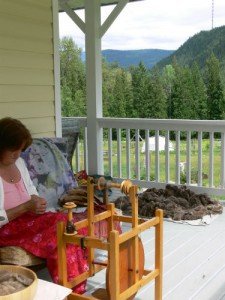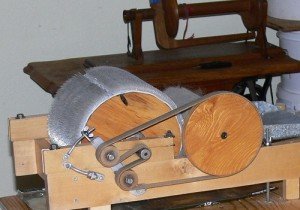It’s a huge leap to make from buying yarn off the shelf to processing the fibre and making your own, but like most things in life, the rewards far outweigh the effort and anyway, what would you be doing with all that time?
Relaxing at the Wheel
Spinning is usually the first step to producing your own yarn; you can buy the batts or roving from fibre suppliers and get cracking on producing that perfect yarn and discovering the pleasure and relaxation to be had from the rhythm of the wheel. If however, you have a yearning to step into the very cauldron from whence cometh that perfectly soft and clean wool, the rewards increase exponentially ……but so does the amount of effort!
I would like to take you through the entire process of producing yarn, beginning on the back of the very animal that ‘donates’ it’s gorgeous coat. These many procedures may not appear on the blog in the order in which they are carried out, it comes down to the weather and the season, to provide the right conditions. Each process can be done in many different ways and we’re only going to cover the way we do things, at least for the moment. Also, our own procedures change as we constantly strive to find ways to reduce the processing time and improve the quality of the finished product, but if we discover a better way, you can be sure you’ll learn about it here.
So how do you convert a thick, dirty and matted heap of fleece into perfect yarn? The processes vary according to the condition and type of fibre, but essentially, it goes like this:
Sheep Fibre:
Fibre Tumbler
Grooming
Clipping/Shearing
Sorting
Rinsing
Scouring
Combing/Carding
Spinning
Plying
Setting
Llama & Alpaca Fibre:
Shearing The Llamas
Grooming
Clipping/Shearing
Sorting
Coarse Picking
Tumbling
Second Picking
De-hairing
Simple Hand Combing
Combing/Carding
Spinning
Plying
Setting
Drum Carder
We don’t have any sheep just yet, so I can’t tell you anything about the grooming process for sheep, but I have seen other people making a really nice job. Grooming before shearing can save a HUGE amount of time and effort in the processing. It’s worth every minute you spend doing it. Watch out though, once they’ve been groomed, they frequently get that desperate urge to roll and rub in the dirt again!
It all sounds straight forward, except that the process changes according to what is being produced. Each animal is unique; some animals have short coats that tend to throw off the hay, straw, twigs and seed heads and the locks are easily separated, making it ideal for de-hairing, whilst others have incredibly dense coats that clump and mat and are magnets for all manner of vegetation. Some animals love to rub on trees and roll in the mud, whilst others have the knack of appearing clean and well groomed the whole time. Rather like children, actually!
If you want to remove the guard hair from the llama fleece, then skip the second picking since it jumbles the fibre too much and makes it more difficult to draw out the long guard hair.
The scouring process also varies from one animal to the next, according to the nature and coat of the animal and how grubby the fleece is. Washing a fleece tends to make it
Clean Llama Fibre
clump. Often with llama and alpaca, it is better to comb and spin before any kind of washing. With sheep wool, we use a very different process to most people. Our system is quite stinky, but thankfully, it doesn’t take place in the house and it is infinitely more Earth friendly than loading it into your washing machine full of very hot water, several times, with a bottle or two of ‘Dawn’ washing liquid!
We will be organising workshops this summer to cover some of these processes, but in the meantime, enjoy the reading. Of course, if you have some tips of your own, we’d love to hear from you.







 Calling All Fiber Artists - all proceeds from the FAB Fiber Arts Store go directly to help the Llama Sanctuary
Calling All Fiber Artists - all proceeds from the FAB Fiber Arts Store go directly to help the Llama Sanctuary
great site, i would like to talk with you about workshops and processing as i live not far from your area and raise sheep. i would be very interested in the spinning aspects as my daughter is learning that, and the wheel is at my home….also i am interested in making batts, but my carder needs new cloth too, and i am interested if you have any ideas, as to where i can order, mine seems to be worn out…and dull.